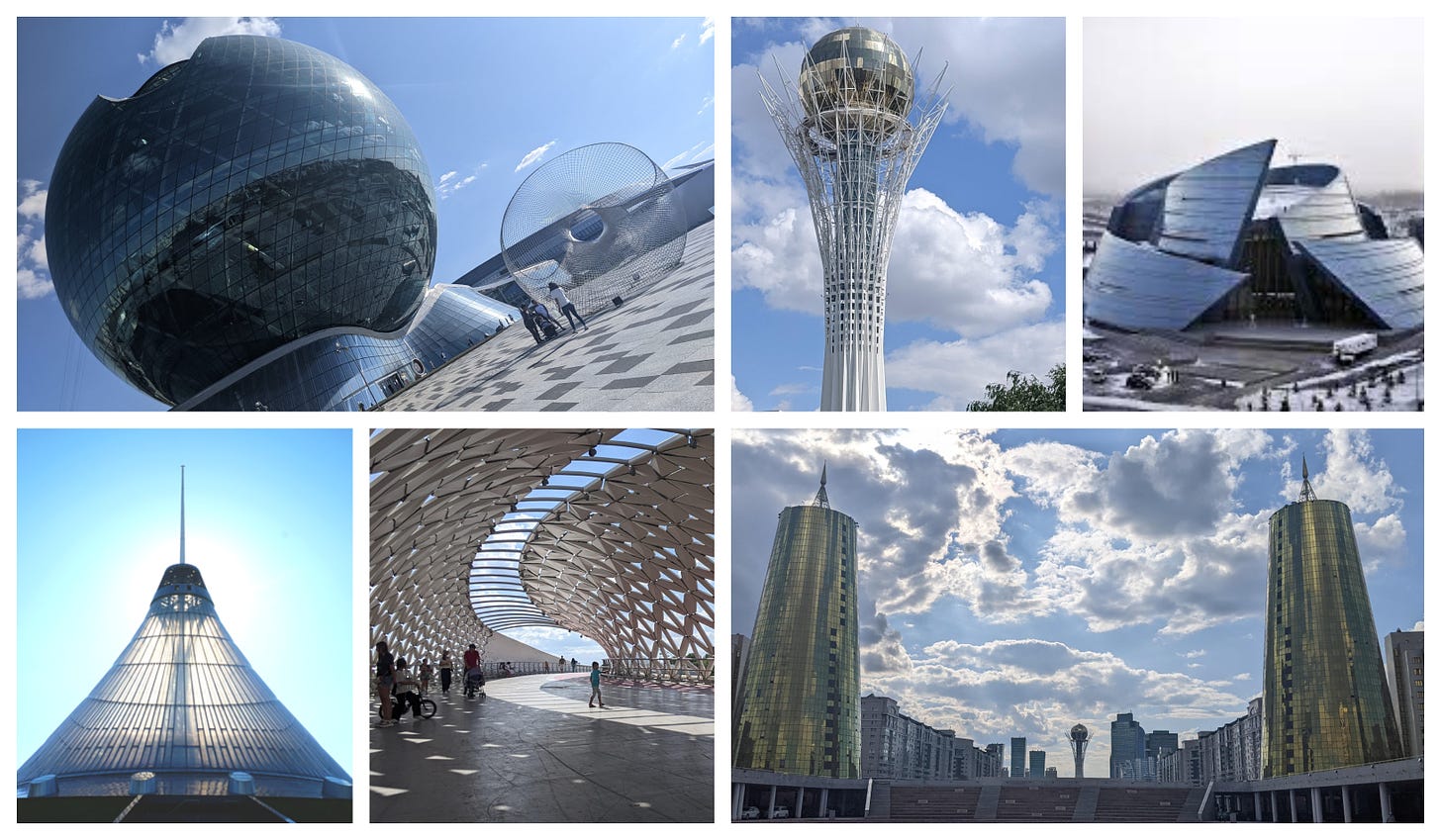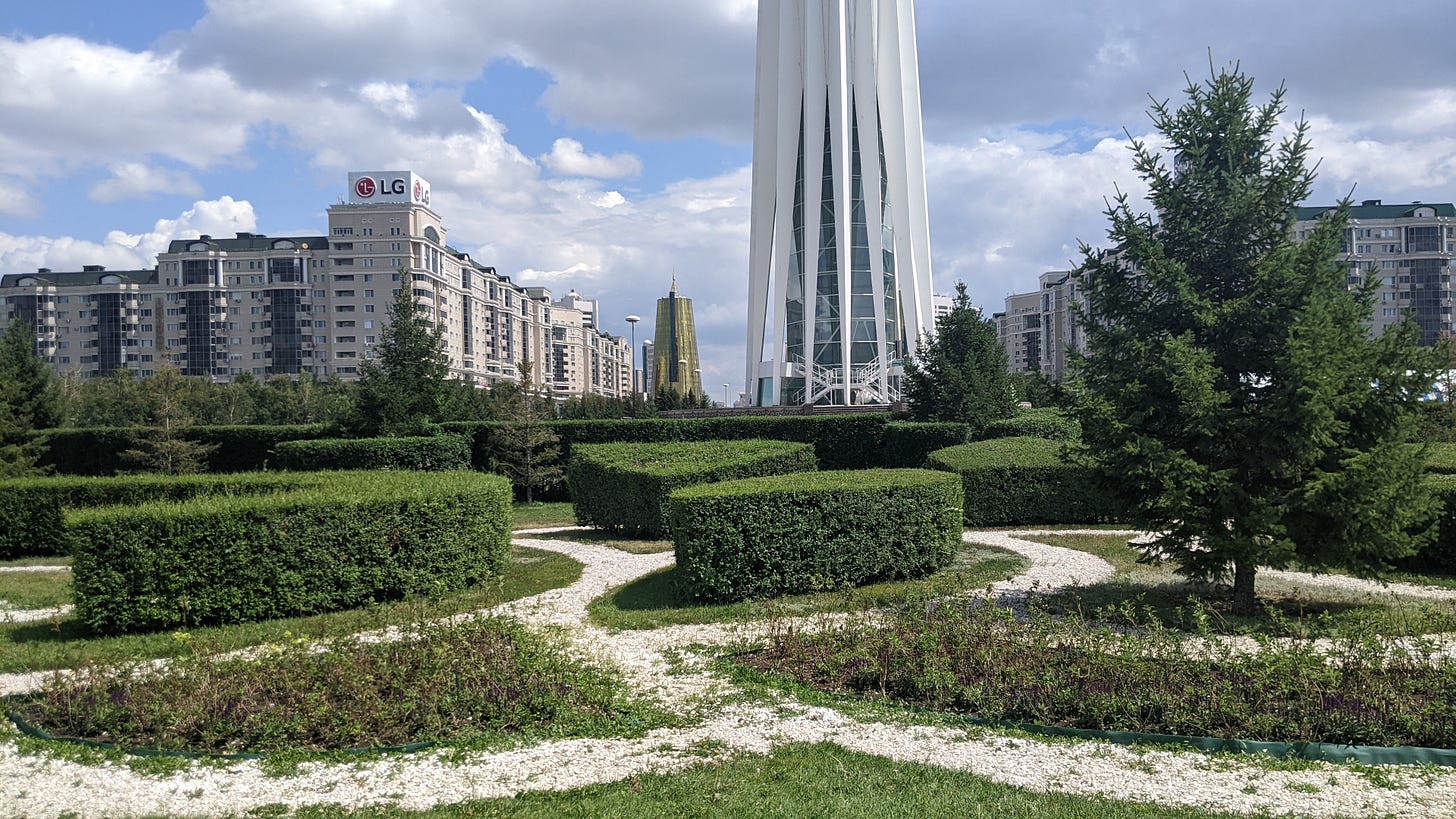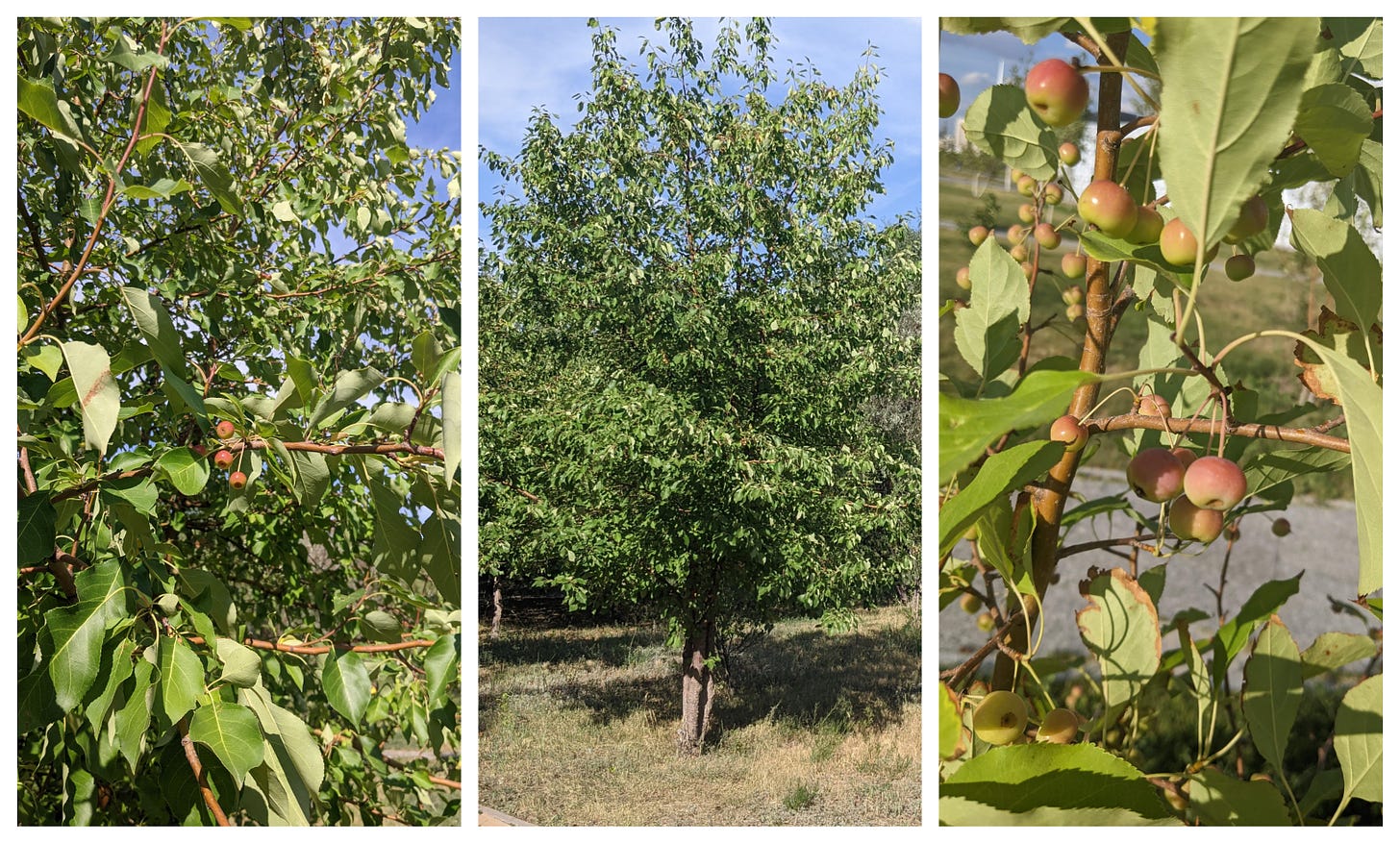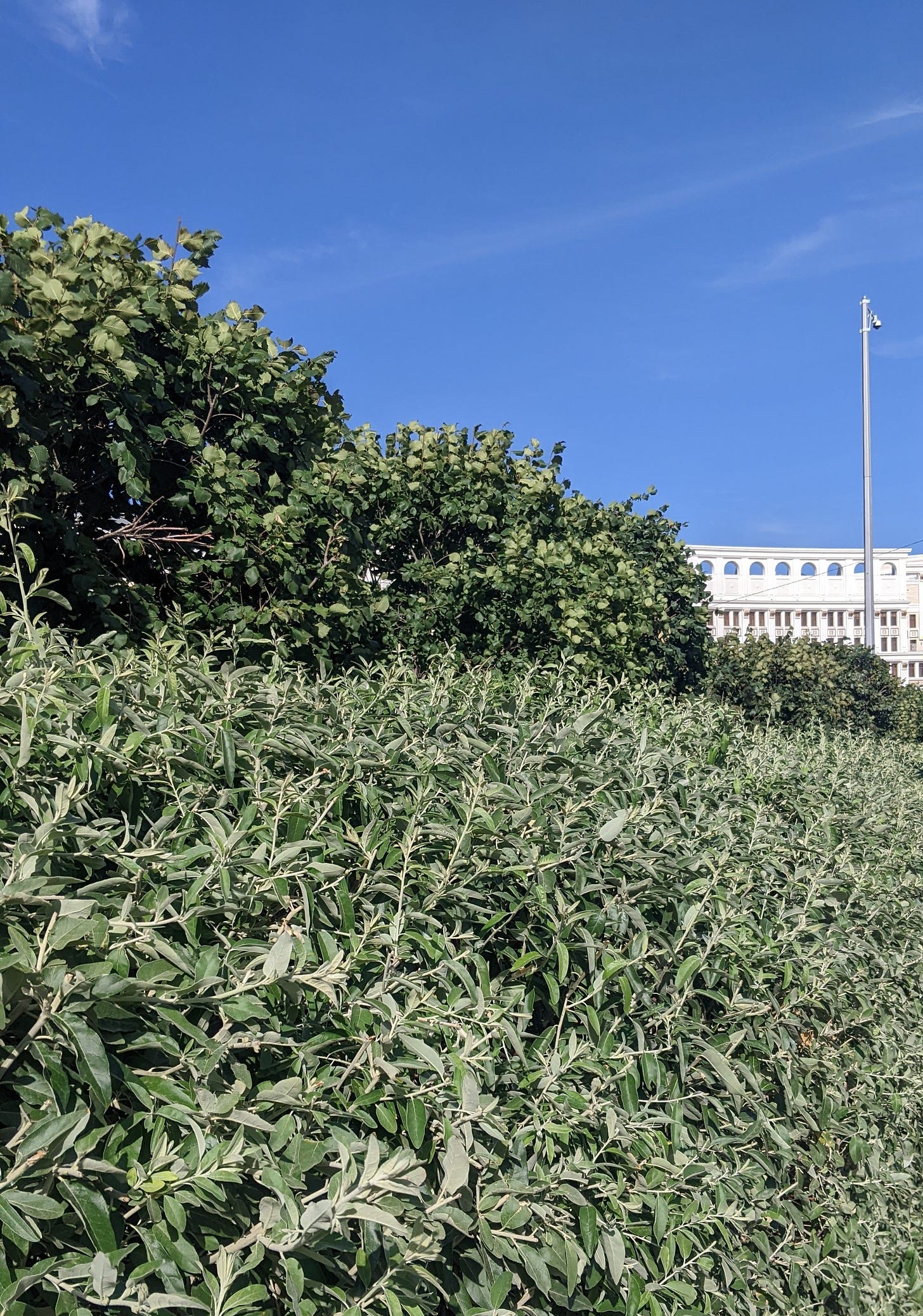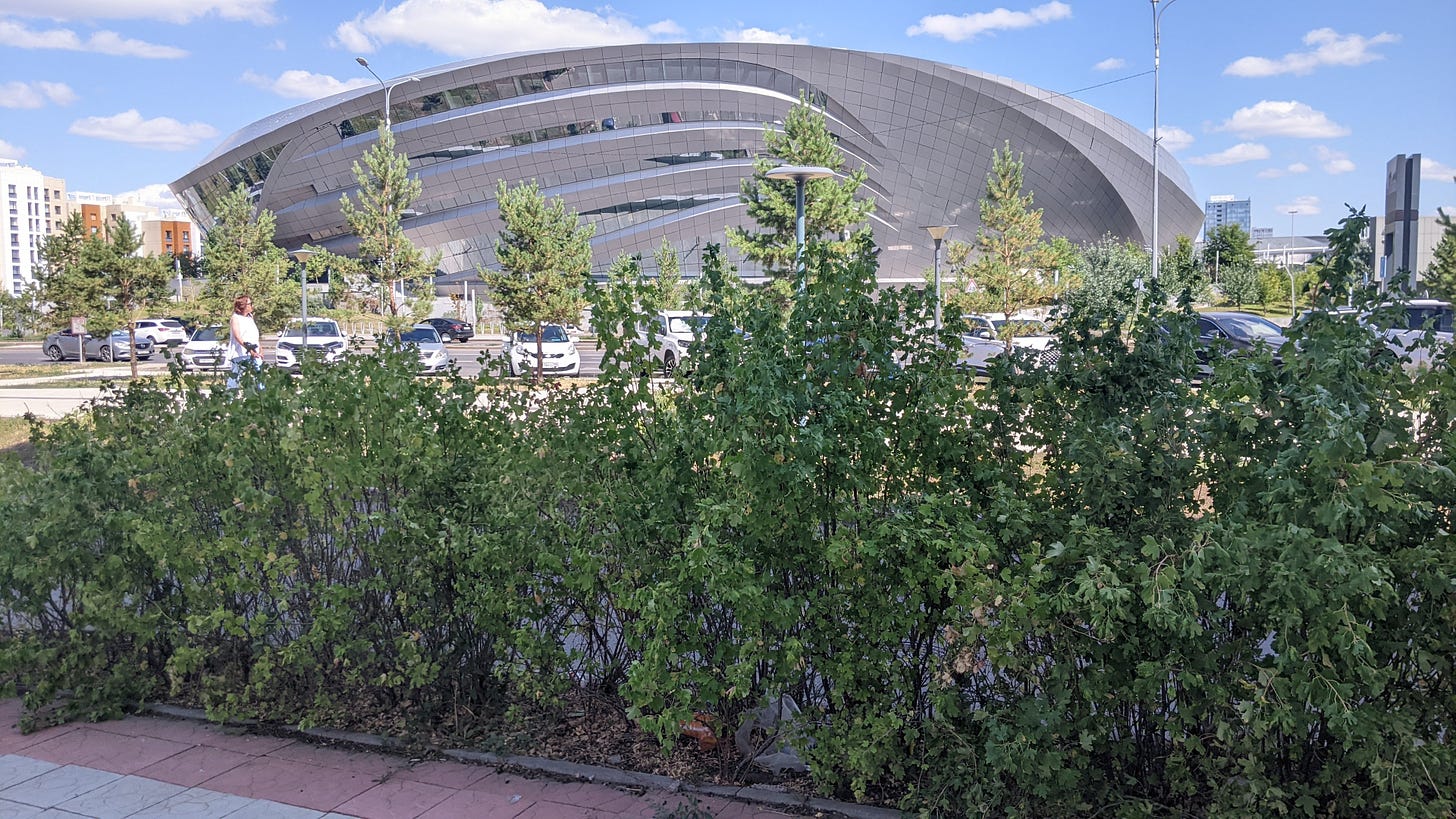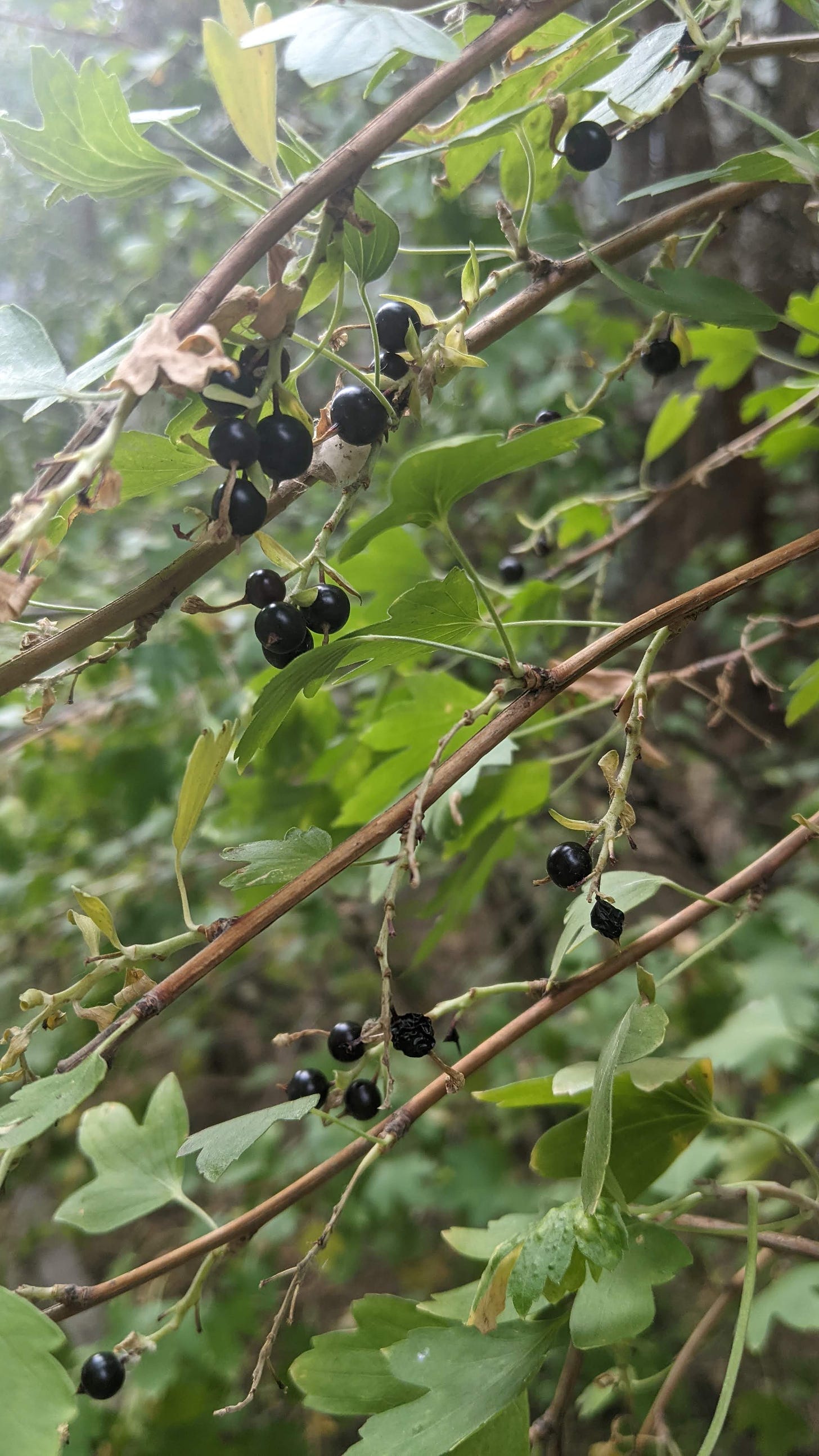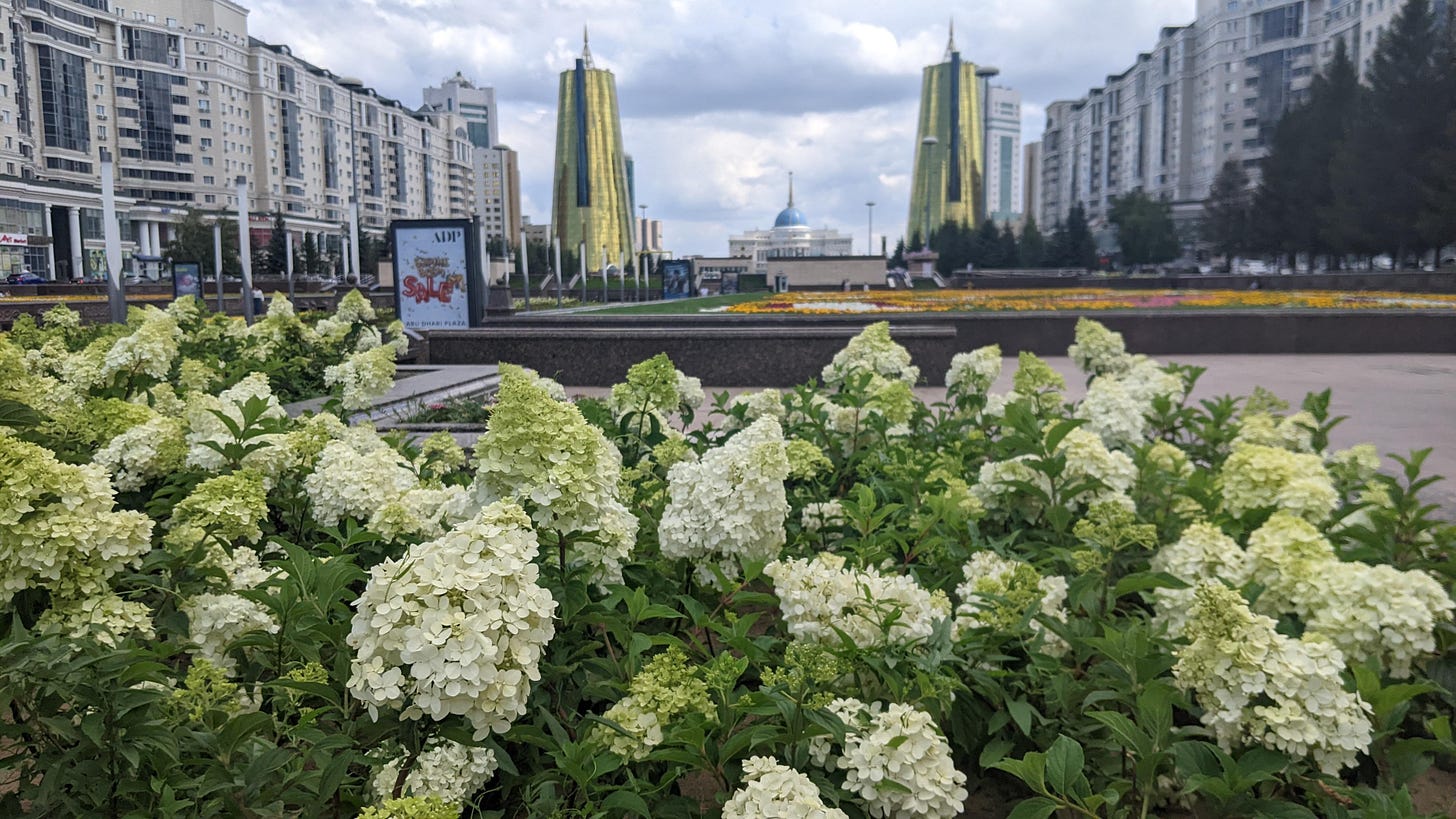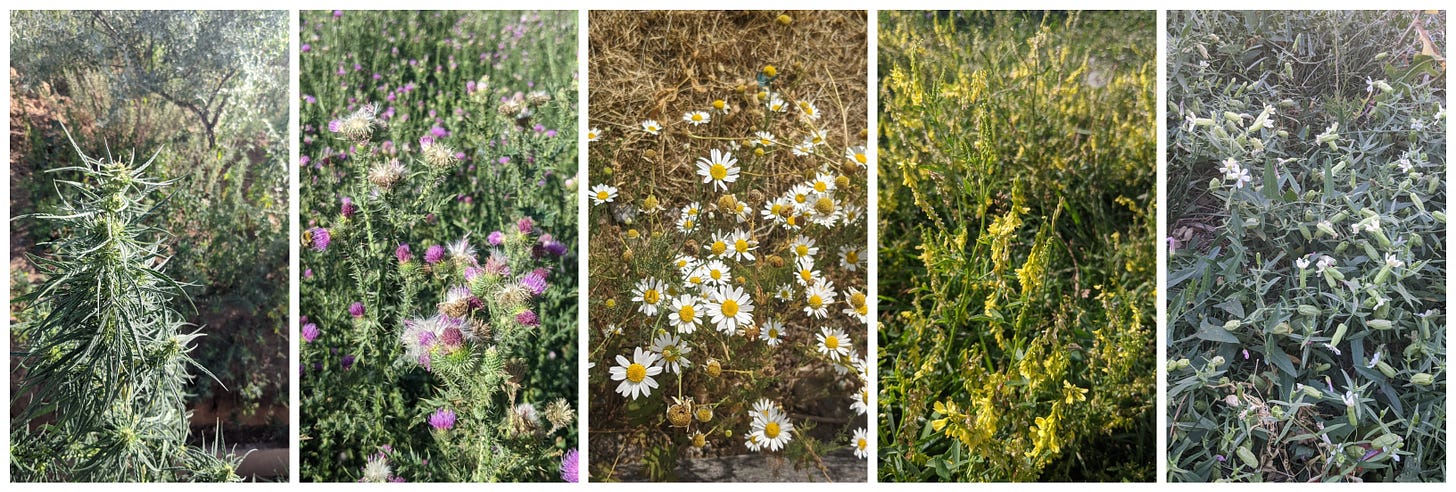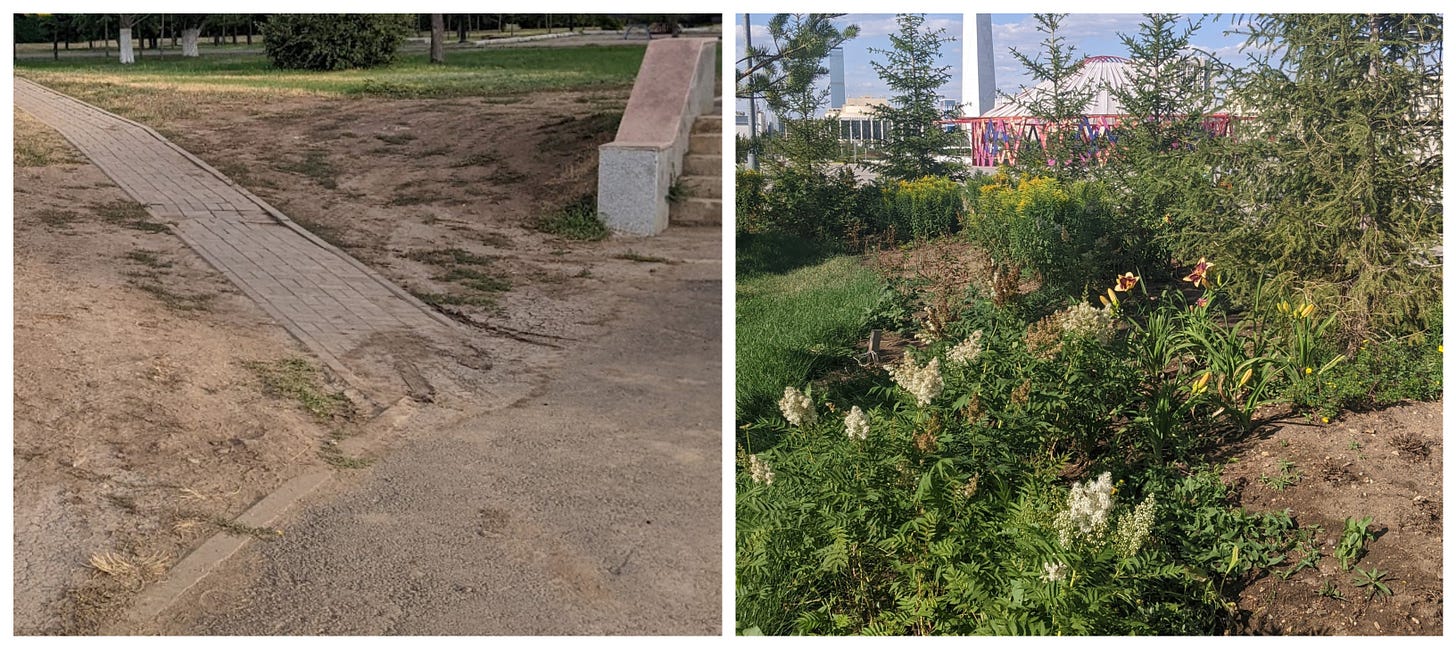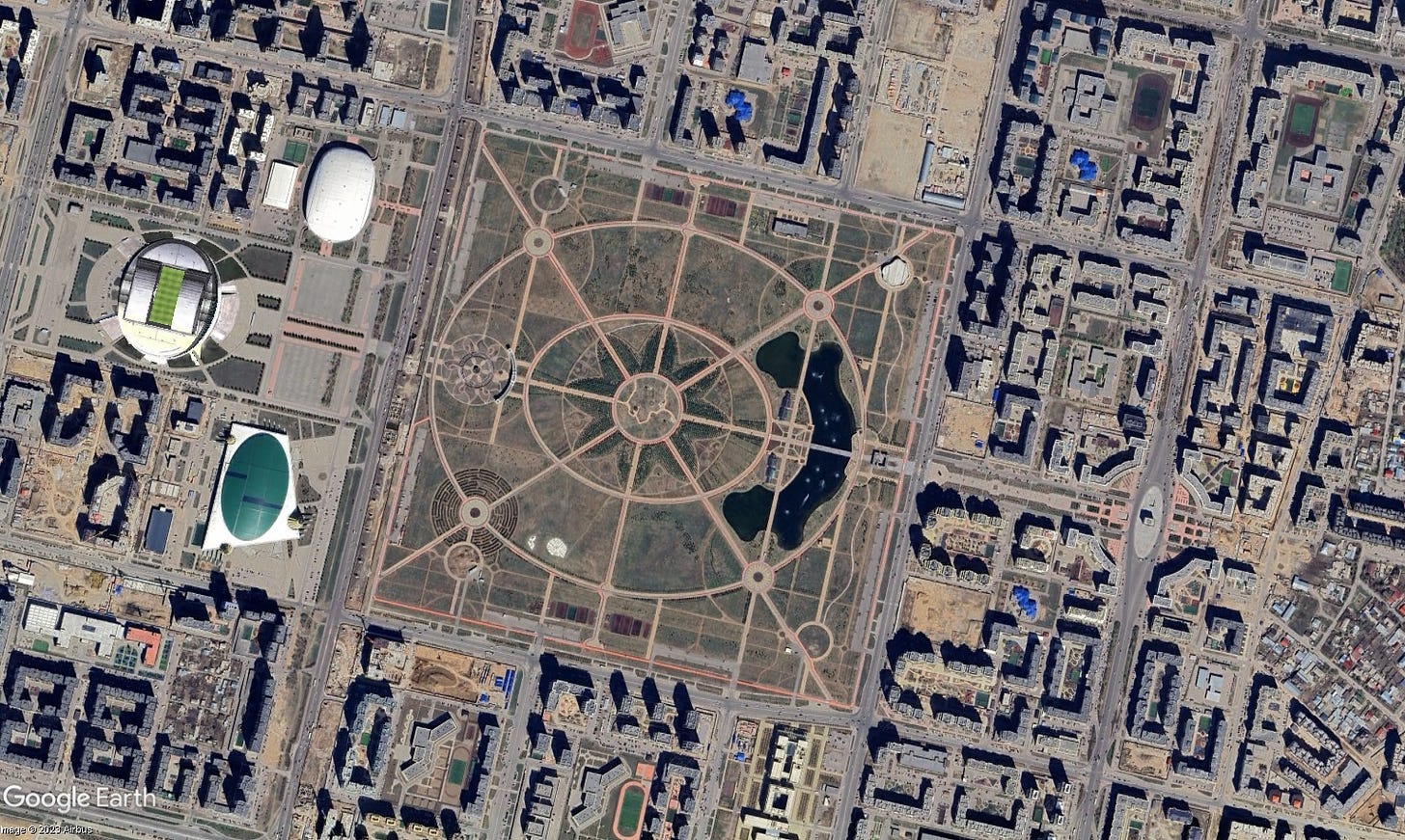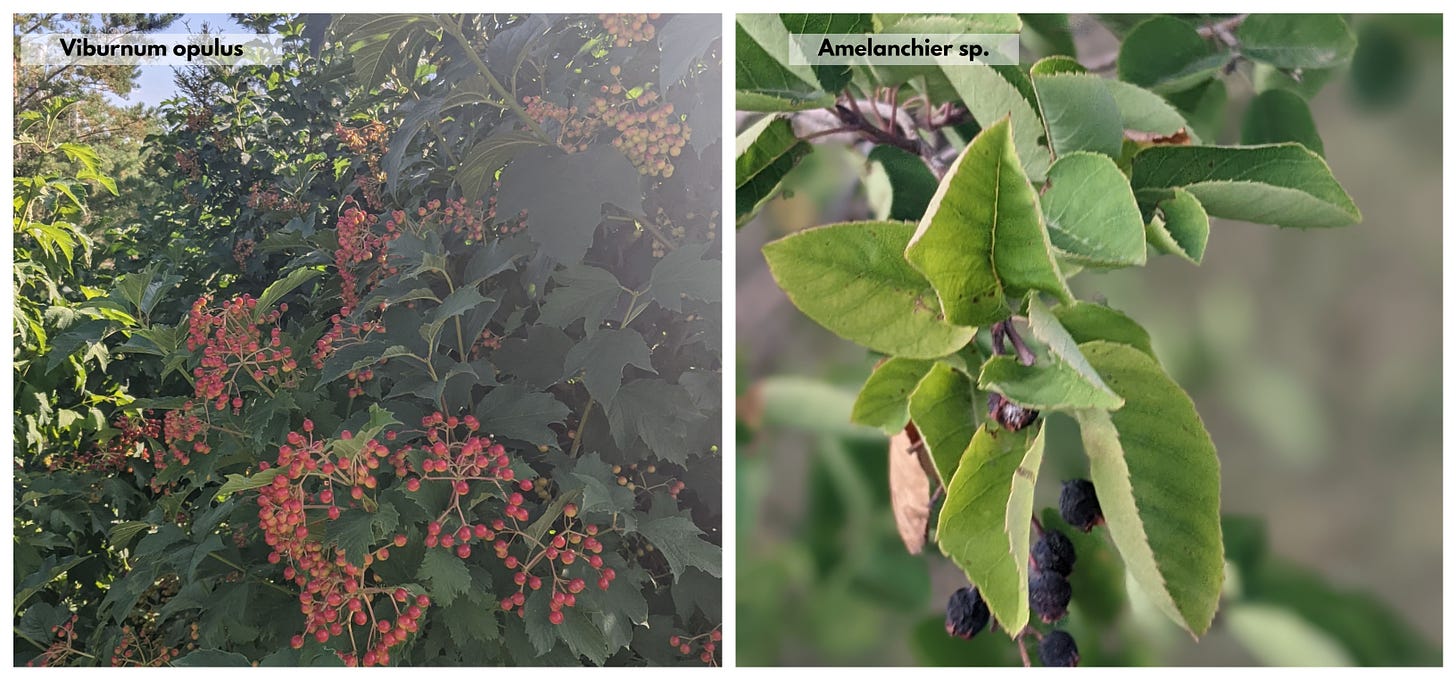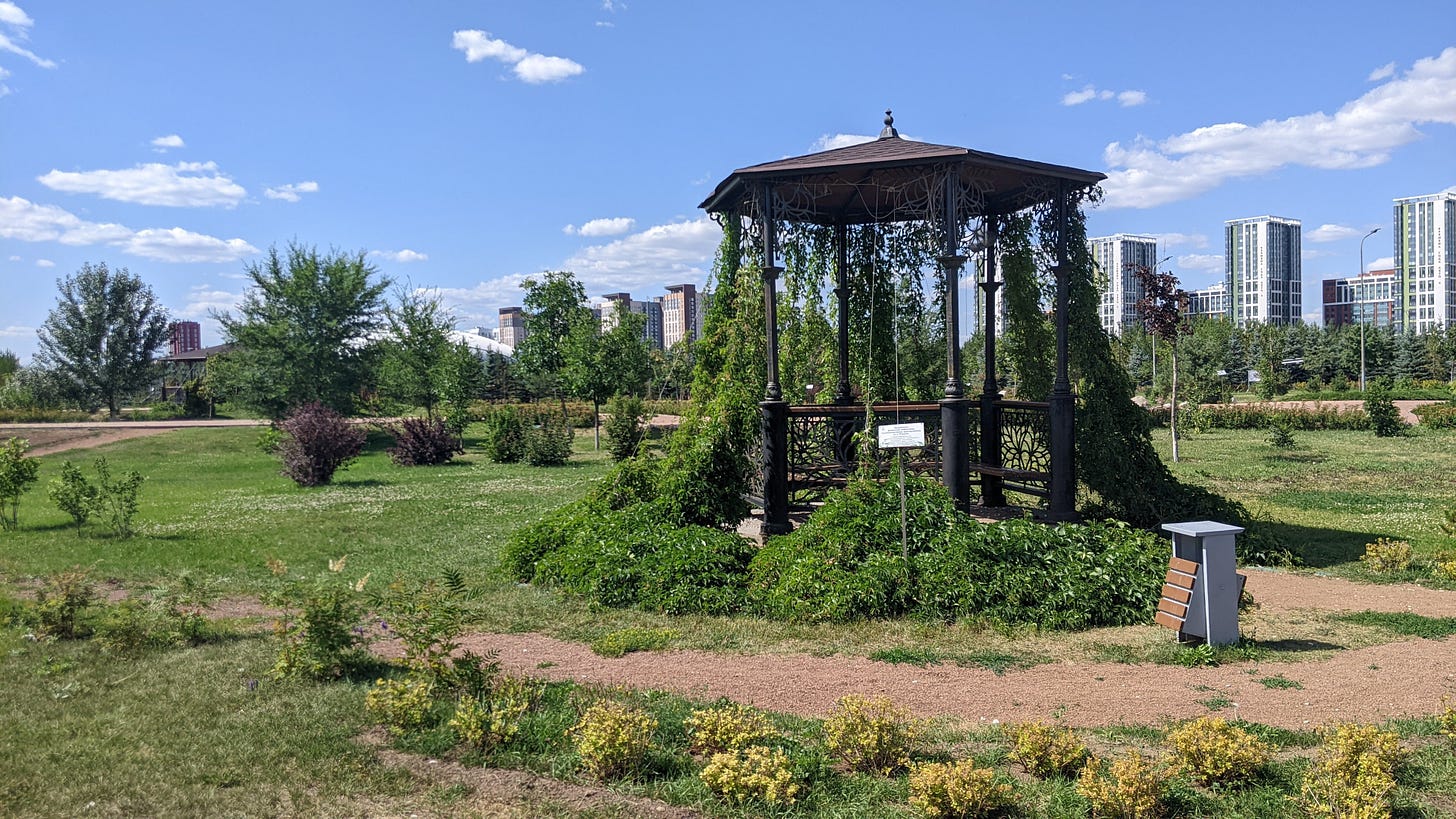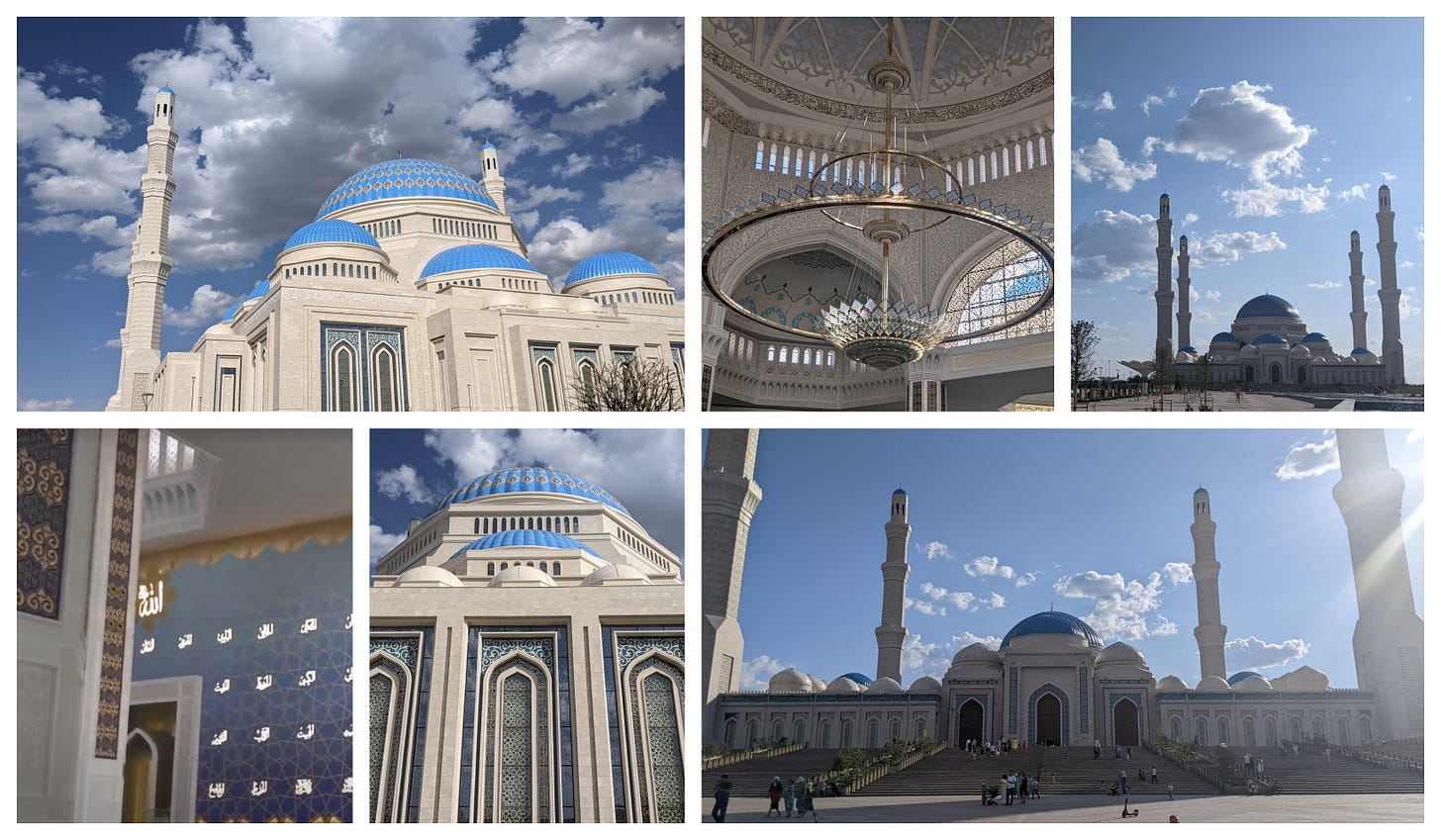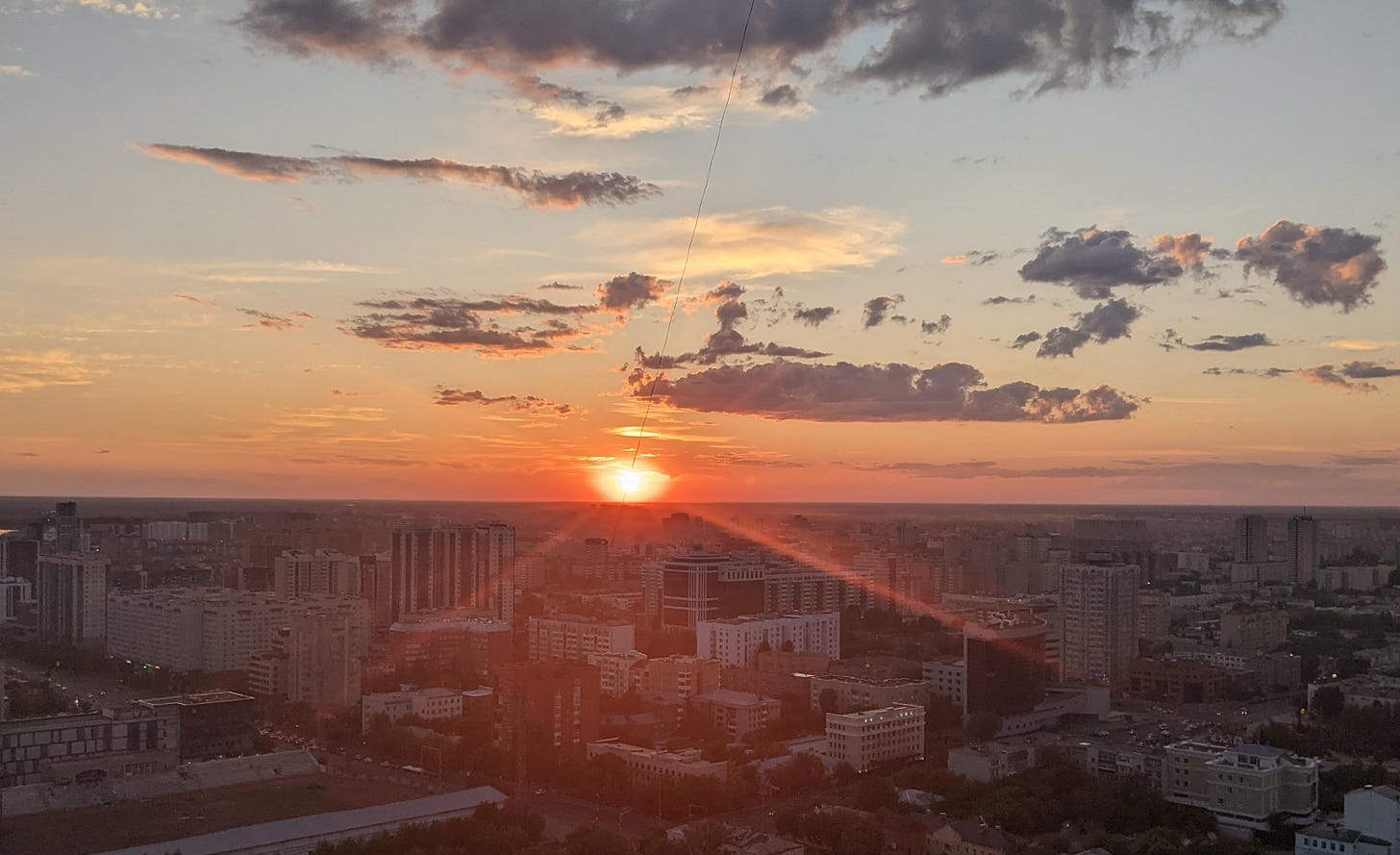Continuing eastward on my travels my next stop is Astana, the new capital of Kazakhstan and when I say new, consider 30 years ago everything in the following photos was Steppe! During this post will look at the challenges of growing trees on the steppe, the flora of the city along with some of the incredible buildings and take a look at probably the youngest botanical garden I’ve ever visited.
The city offers a pleasing combination of comfort, grandeur, and open spaces, with a relaxed and friendly atmosphere among its inhabitants. Although I typically dislike grid layouts, in this case, the flat terrain of the Eurasian Steppe complements the city's impressive Starwaresque architecture, accentuated by the expansive skies. The River Ishim, flowing through the city with parks and gardens along the banks, adds a serene touch to the overall ambiance, especially so during the long summer evenings.
The climate here is extreme continental climate with hot summers, featuring occasional brief, but hard, rain showers and long, very cold, dry winters (Dfb on the Köppen climate classification system) I’m not sure I would like to spend a Winter here given the 6 months of snow and bone chilling winds, so I’m told, but the summer is pretty glorious.
Common Street Trees of Astana
Tree planting in the steppe comes with it a range of challenges. In some places the water is too high, there are high levels of soil salinity, the continental climate with swings of -40C in winter to +40C in the summer, low precipitation with a an average 150-250 mm/year and to top it all off, wicked winds from all directions. Nevertheless, Astana offers a wonderful opportunity to witness the profound impact trees can make in a city, not only aesthetically speaking but also providing a cooler and more comfortable environment.
As you explore the city, you'll notice how the more recently developed areas, especially around the periphery, have been adorned with newly planted trees. However, it becomes evident that these areas are noticeably warmer compared to the parts of the city where trees planted 30 -20 years ago, have flourished.
Elms feature heavily around the city both as trees usually Ulmus parvifolia - Chinese Elm) and as hedging, Ulmus pumila - Siberian Elm, that is often tightly trimmed. All plants in the Ulmus genus have edible seeds, called samaras with Siberian Elm reportedly being one of the tastiest.
Poplars are popular, populating parks and promenades, including, Populus simonii - Chinese Poplar and Populus alba and Populus nigra ‘Italica’. Betula pendula, Pinus sylvestris and Sorbus aucuparia are also used extensively along with Salix pentandra - Laurel Willow.
Interestingly, Salix species present a valuable option as an emergency food source, offering sustenance in times of need. While it may be ambitious to attribute culinary excellence to these plants for humans, their young shoots and inner bark are indeed edible and can be consumed either raw or cooked to provide nourishment.
Probably the most unique street tree I came across was a species of Apple , possibly, Malus sieversii, a wild species of apple from the southern regions on Kazakhstan and often considered the parent species of all apples and the many 1000s of cultivars that exist in the world today.
Hedging Plants in Astana
Elaeagnus angustifolia - Russian Olive hedging is relatively popular along the streets around the banks of the Ishim River. This is a great biomass plant and can probably be trimmed a few times a year, providing plenty of nitrogen rich mulch for establishing soil in other areas. This is valuable biomass given how shallow the soils appear to be in the parks around the City.
Caragana arborescens - Siberian Pea Tree is planted often around the city and generally kept trimmed as small free standing shrubs but also used in hedging. These are sun loving plants but on the North side of the river they appear to do well under the Acer negundo - Box elder avenues trees. I’ve never seen Acer negundo - Box elder as large as this before and the trees have obviously been pollarded in the past so were probably taller before cutting.
Golden Currant - Ribes aureum hedges seem to be relatively common in Kazakhstan as I’ve seen them in every city so far, and the majority of them are full of fruits.
This is an interesting choice for hedging and after seeing so many successful examples here, is something we’ll be planting in our gardens in Shipka. The fruits are a little sweeter than Ribes nigrum, the leaves smaller and lighter and the flowering more obvious with bright yellow flowers emerging in the spring.
Ribes nigrum - Black Currant tend to rot from the center over time so do not make great hedging unless you prune out the old growth on a regular basis. I’ll probably include them along with Mahonia aquifolium, Elaeaguns x ebbingei and Chaenomeles speciosa to make a partially evergreen edible polyculture hedge.
Herbaceous Plantings
I’m not a huge fan of mass annual planting but it seems plenty of people are and lots of attention is given to formal annual beds around the center and in the parks. One great thing about these planting schemes is that they provide a ton of regular and dignified work both for nurseries and gardeners.
Hydrangea paniculata hardy to USDA zone 3 , seems like a great option for cold climates and tolerates the high summer heat too. These plants do particularly well on very acid soils with a pH around 4.5. The flowers contain up to 4.06% rutin, a naturally occurring flavonoid in many foods.
Wild City Plants
It’s always interesting to observe the wild plants that grow around a city and the majority of the time (within similar climate zones) it’s the same species but you’ll always find a few unusual species. The wild plants that grow in an area are an excellent example of what you should be growing if you are looking to cover poor soils and build biomass above and below the soil. Wild herbs growing within the city of Astana included Cannabis sativa, what I think is Welted Thistle - Carduus acanthoides, a prostrate (variety or sub species possibly) Saponaria officinalis and various nitrogen fixing legumes that I've yet to identify. The invertebrate activity is pretty good given how strong and frequent the wind is and the lack of large tree cover.
I think the C.sativa is a feral strain, with very low THC content, perhaps escaped from local hemp production that the Kazakh government has been experimenting with recently to avoid paying the higher prices of paper import.
There are lots of bare patches of soil within the city parks and green spaces and many spots that are obviously struggling. This is partly due to climatic factors with, high temperatures, low precipitation and strong winds but primarily due to shallow soils the plants have initially be set in and poor layout and grading that facilitates rainwater runoff. From my casual observations it was obvious that the areas with deeper soils, with slight depressions, where soil, biomass and water would naturally accumulate, were performing remarkably well with many beneficial volunteer plants established and lots of invertebrate activity.
Regenerative Landscape Design - Online Interactive Course
Want to learn how to design, build and manage regenerative landscapes? Join us on our Regenerative Landscape Design - Online Interactive Course. We look forward to providing you with the confidence, inspiration, and opportunity to design, build and manage regenerative landscapes, gardens, and farms that produce food and other resources for humans while enhancing biodiversity.
You can find the course details here and at the moment we have a $350 ( 20%) discount for full enrollment to the course. Just use RLD2024 in the promo code section of the registration form to receive your discount.
The Astana Botanical Garden
The Astana Botanical Garden was built in 2016-2018 and opened to the public on July 2, 2018 making this the youngest Botanic garden I have ever visited. It covers an area of 92 hectares, 63 hectares of vegetation the rest bike lanes, pathways, monuments, fountains, lakes etc.
Large sections of the garden are planted with one species of tree or shrub in rows and it appeared like these parts of the garden had been established as experiments. Indeed a little googling revealed the garden was built to serve as a scientific research center to test the viability of species that are good for growing in the Steppe, as well as for public utility, that garden certainly gets a lot of.
Species of interest within the Botanic Garden include a range of Amelanchier spp. including Amelanchier ovalis, Amelanchier sibirica, Amelanchier lamarckii and Amelanchier canadensis. These are a great choice for continental climates seeing as the plants can tolerate very cold conditions of winter and are drought-tolerant during a hot summer. They are also relatively pest- and disease-free. All of the plants i noticed seemed healthy although the fruits were shriveled presumably from the heat and lack of water. Viburnum opulus grows very well, a deciduous shrub native to Europe, northern Africa, and parts of Asia, belonging to the Adoxaceae family. The fruits are edible but more suitable for the birds given the bitter taste and fiddly fruit.
Aronia melanocarpa - Chokeberry was probably the most heathy looking and abundant fruiting shrub in the gardens with a bumper crop of berries on all of the plants.
Shepherdia argentea - Silver buffaloberry from Elaeagnaceae was also producing large amounts of fruit and is a plant I have been on the look out for, for many years The taste is very similar to Elaeagnus umbellata. A native to central and western North America, it is extremely cold- and drought-tolerant, making it a popular choice for landscaping in harsh climates.
It was the first time I’ve met Malus niedzwetzkyana, commonly known as the Red Crabapple a tree species that hails from Central Asia. Its striking features include dark red to purple foliage and a magnificent display of vibrant pink blossoms in the spring that attract pollinators and human admirers alike. This small tree also produces the tiniest apples, that are edible but probably best left to be enjoyed by the birds given their tiny size.
What appears to be an experimental perennial herb garden can be found around the central area. Many of the herbs we grow for wildlife in our gardens such as Tanacetum balsamita -Alecost , Allium spp. and Tanacetum vulgare - Tansy can be found growing here and aside from the wild patches of Welted Thistle - Carduus acanthoides, it was the highest invertebrate activity I came across.
Around the garden you can find plenty of pergolas of various sizes with Parthenocıssus trıcuspıdata - Boston Ivy growing up strings
In the center there is a large pond and a greenhouse with eight laboratories, a seed bank, and a herbarium fund. It’s going to be really impressive visiting this garden again in 5 or 6 years , given the "S-curve" growth pattern of the majority of plants in the garden, the contrast will be intense.
Welcome to our Online Store where you can find Forest Garden/ Permaculture plants, seeds, bulbs and Polyculture multi-packs along with digital goods and services such as Online Courses, Webinars and eBooks. We hope you enjoy the store and find something you like.
It's your purchases that keep our Project going! Enter Our Store Here
The Grand Mosque of Astana
It’s probably impossible not to be captivated by the awe-inspiring beauty of The Grand Mosque of Astana, a magnificent architectural masterpiece, and even more magical given its location right on the southern edge of the city, where urban life seamlessly merges with the vast steppe. I wonder whether the architects and builders of this incredible structure had in mind how awesome it would appear with the vast backdrop of the widest skies of Kazakhstan.
As an appreciator of all religions and attempting to see the best and worst in all of them equally, I feel it safe to say that if there is one thing (very generally speaking) the West misunderstands the most about the East, it’s Islam. I think that was true even before the relentless post-9/11 barrage of propaganda. I can't remember the last monumental church I was in where you hear laughter and children play freely.
The immediate area surrounding the mosque is an expanse of decorative paving, and fountains with very young trees (the project was completed last year) and herbaceous perennial borders including one of my favorite edible perennials Hemerocallis fulva - Orange Daylily. The whole South of the city is perfect for biking or scooting with open roads and very little traffic. In fact the whole city is great for bikes and scooters with dedicated lanes everywhere, but its not so great for walking around given the spaciousness of everything.
As the sun sets in the west of the city it highlights the magnificent expanse of the Steppe. Looking over the horizon, I imagine our ancient ancestors setting up fires for the night, gathering the children and preparing the evening meal. I also imagine the new city skyline 30 years from now.
When contemplating the Nomadic culture of this region, that dominated the past for so many millennia, it’s interesting to consider that nowadays only an estimated 0.4% of the worlds population practice nomadic pastoralism (mostly in the arid and semi arid regions of Africa) and that in 2023 “digital nomads” surpassed nomadic pastoralists, making up 0.5% of the population. It seems pretty obvious to me that the number of “digital nomads” is almost certainly going to grow and perhaps exponentially at some point. I wonder what long term consequences will result from this? Instinctively, I believe mostly positive but not without some darkness before a dawn. Perhaps in a 100 years or so it will be a contingent of the digital nomads to unite others in common purpose and collectively achieve a shake up as vigorous as their nomadic ancestors did.
Support Our Project
If you appreciate the work we are doing you can show your support in several ways.
Become a member of the Bloom Room. A $70 annual or $7 per month subscription to our Substack provides you with access to live sessions, design tutorials, a members forum and more, see details here.
Make a purchase of plants or seeds from our Nursery or Online Store
Joining us for one of our Practical Courses or Online Courses
Comment, like, and share our content on social media.
If you appreciate the work we are doing you can show your support in several ways.
Become a member of the Bloom Room. A $70 annual or $7 per month subscription to our Substack provides you with access to live sessions, design tutorials, a members forum and more, see details here.
Make a purchase of plants or seeds from our Nursery or Online Store
Joining us for one of our Practical Courses or Online Courses
Comment, like, and share our content on social media.


